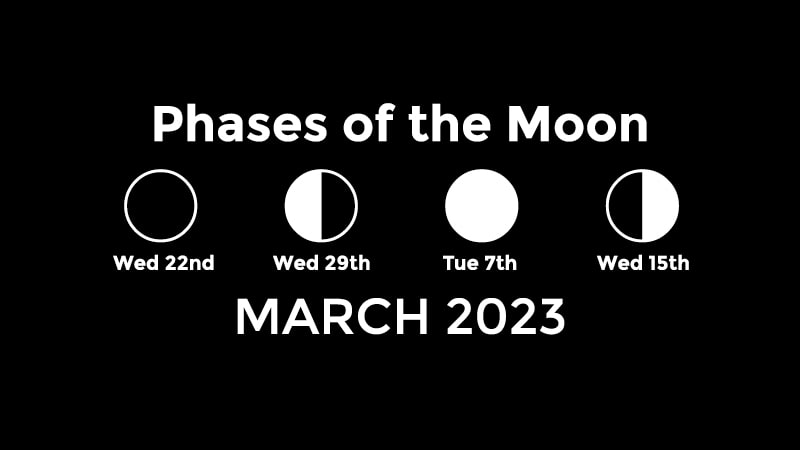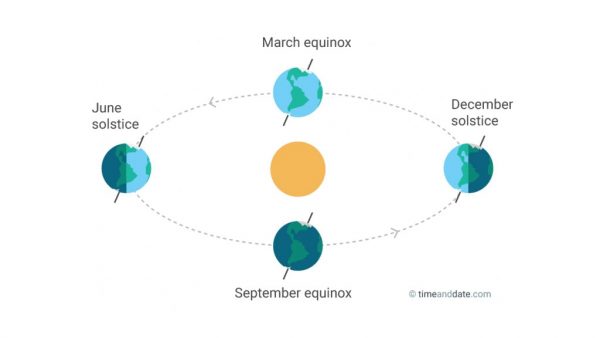Find out what to go out and look at this month
Planets:
Mercury can be found in the constellation of Capricorn (The Sea-Goat) in the early morning. It’ll be lost to the Sun’s Glare after the first week of March. Venus starts off March between the constellations of Cetus (The Sea Monster) and Pisces (The Fish) and by the middle of March, it’ll move into the constellation of Aries (The Ram). You can find Mars for most of March in the constellation of Taurus (The Bull). By the end of March, it’ll move into the constellations of Gemini (The Twins).
Jupiter can be found up very low in the west until the middle of March in the constellations of Pisces. On the 2nd of March, Jupiter will be extremely close to Venus. It’ll be within half a degree away (One moon-width) from Venus. Saturn reappears very low in the eastern morning sky. You can locate it in the constellation of Aquarius (The Water Bearer) throughout March. Uranus can be found in between the constellations of Aries (The Ram), Cetus, and Taurus. on the 31st of March, Uranus is very close to Venus. Neptune reappears in the morning sky at the end of March. It can be located in between the constellations of Pisces, and Cetus.
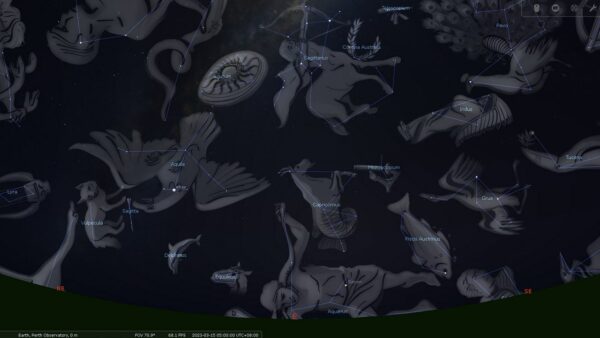
|
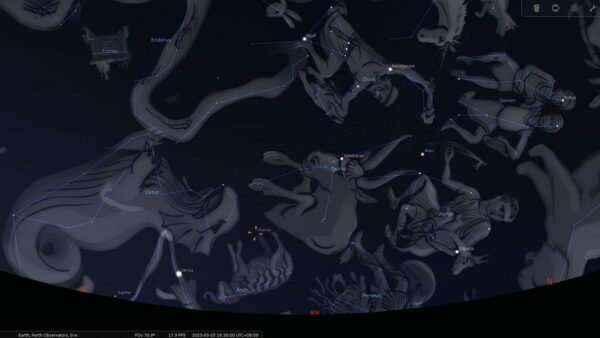
|
| Planet | When It Rises Or Sets |
|---|---|
| Mercury | From the middle of February, it’ll rise at 04:59 am (AWST), and by the end of the month, it’ll be lost to the Sun’s glare |
| Venus | At the start of February, it’ll set at 08:14 pm (AWST), and by the end of the month, it’ll set at 07:57 pm (AWST) |
| Mars | At the start of February, it’ll sets at 11:45 am (AWST), and by the end of the month, it’ll set at 10:52 pm (AWST) |
| Jupiter | At the start of February, it’ll set at 08:18 pm (AWST), and by the end of the month, it’ll be lost to the Sun’s glare |
| Saturn | At the start of February, it’ll rise at 05:13 am (AWST), and by the end of the month, it’ll rise at 03:41 am (AWST) |
| Uranus | At the start of February, it’ll set at 09:52 pm (AWST), and by the end of the month, it’ll set at 08:10 pm (AWST) |
| Uranus | At the end of the month, it’ll rises at 05:19 am (AWST) |
Conjunctions And Occultations:
Conjunctions involve object(s) in the Solar System and/or more distant objects, such as a star. It’s an apparent phenomenon in which multiple objects which aren’t close together appear close in the sky and it’s caused by the observer’s perspective.
In an occultation, an object passes across the line of sight between an observer and another object. A solar eclipse is an occultation of the Sun by the Moon.
- 02/03/23 – Conjunction of Venus, and Jupiter (Where to look)
- 02/03/23 – Conjunction of The Moon, Castor, and Pollux (Where to look)
- 06/03/23 – Conjunction of The Moon, and Regulus (Where to look)
- 10/03/23 – Conjunction of The Moon, and Spica (Where to look)
- 15/03/23 – Conjunction of The Moon, and Antares (Where to look)
- 20/03/23 – Conjunction of The Moon, and Saturn (Where to look)
- 24/03/23 – Conjunction of The Moon, and Venus (Where to look)
- 26/03/23 – Conjunction of The Moon, and Pleiades (Where to look)
- 28/03/23 – Conjunction of The Moon, and Mars (Where to look)
- 30/03/23 – Conjunction of The Moon, Castor, and Pollux (Where to look)
Astronomical Events This Month:
The March Equinox:
On Tuesday the 21st of March, The Northward Equinox occurs at 05:24 am (AWST), marking the beginning of astronomical Spring for the Northern Hemisphere, and the start of Autumn for the Southern Hemisphere. This is an exact moment when the Sun’s declination equals 0 as seen from the Earth. The two points where the ecliptic or the imaginary path the Sun seem to trace out along the celestial sphere meets the celestial equator are known as the equinoctial points.
The Equinox (literally meaning ‘equal nights’ in Latin) means that night and day are nearly equal worldwide, and that the Sun rises due east of an observer on the equinox and sets due west. The term Equilux is sometimes used to discern the difference between the true Equinox and the point when sunlight length equals the length of the night. Several factors play a role in this, including the time it takes the physical diameter of the Sun to clear the horizon, atmospheric refraction, and the observer’s true position in their respective time zone. The Equilux occurs within a few days of either Equinox.
Things to Look at This Month:
Christmas Tree Cluster:
The Christmas Tree Cluster (NGC 2264) is a young open cluster located in the constellation Monoceros (The Unicorn). It’s part of the NGC 2264 region, along with the Cone Nebula and the Fox Fur Nebula. The cluster is located 2,700 light-years away from Earth and about 30 light-years across. The stars in the cluster were formed very recently from the surrounding molecular cloud. The cluster contains more than 600 stars that are 1 to 4 million years old.
The Christmas Tree Cluster is visible to the naked eye in good conditions and appears quite striking in binoculars. The Christmas tree shape can be seen in small telescopes at low power. The cluster can be found using the brightest stars of Orion and following a line drawn from Bellatrix to Betelgeuse to the east and a little bit north. The Christmas Tree Cluster is named for its triangular shape, formed by very young stars, that looks like a tree in visible light. It is in the northern part of NGC 2264, just above the Cone Nebula. The Christmas Tree Cluster was discovered by William Herschel on January 18, 1784.
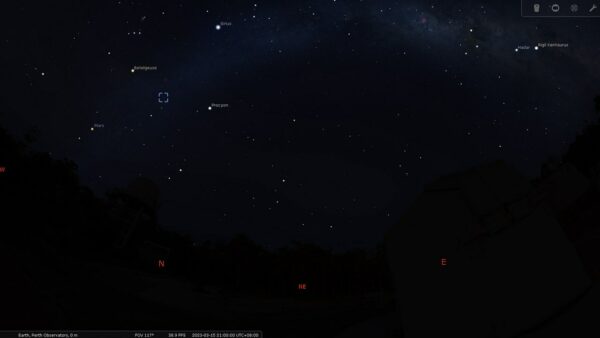
|
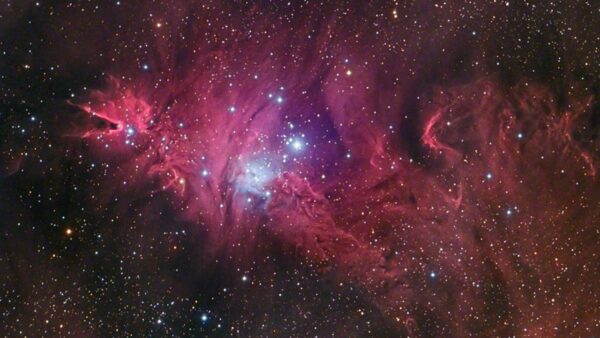
|
Beehive Cluster:
The Beehive Cluster (M44) is an open cluster of faint stars in the constellation of Cancer, and it’s also known as Praesepe (Latin for manger). The cluster is not quite bright enough to clearly be seen as stars but more like a ‘cloud’. It’s easily visible to the naked eye and has been known since prehistoric times. Since the Greeks in ~3 centuries BC, it has been described as a small cloud or nebula and is the origin of the term as no other naked eye object had a similar appearance.
Its true nature was not shown until Galileo used the first astronomical telescope in 1609 to discover that it was in fact a collection of about 40 stars. We now know of 200 core stars, but there could be possibly up to 1000 stars in an extended area of nearly 3 Moon diameters. The cluster is 15 light-years in diameter, and it is 550 light-years away from Earth. The cluster contains a high proportion of variable stars of age 500-700 million years, this age of the cluster and its proper motion also coincide with those of the Hyades cluster in the constellation of Taurus, which suggests they may share similar origins.
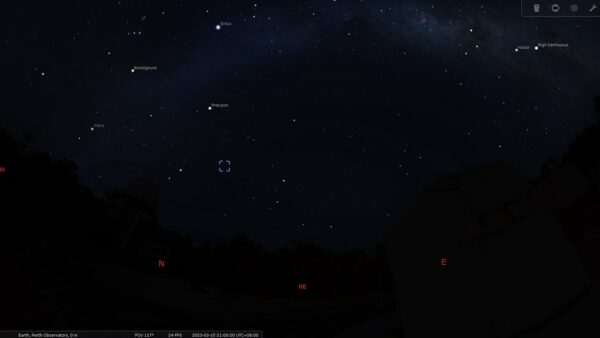
|
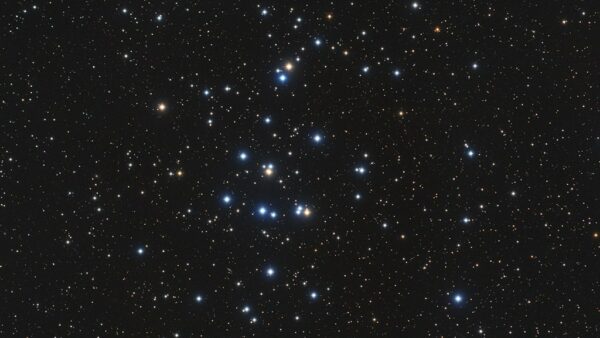
|
The Ghost of Jupiter Nebula:
The Ghost of Jupiter Nebula (NGC 3242) is a planetary nebula with a blueish-green tinge in the constellation of Hydra (The Water Snake) and it’s located 1,400 light-years away from Earth while being 0.3 light-years across. It’s one of the brightest planetary nebulae, however, it’s less than 1 arc minute in size and so it needs a high magnification and a large aperture telescope (16″ or more) to show its structure well. A planetary nebula is an emission nebula. However, rather than being a star formation area like the Orion Nebula (M42), it’s part of the late lifecycle of a star than has blown off a shell of material in a nova-style explosion. This shell of gas is irradiated by ultraviolet radiation from the remaining white dwarf and results in the emission nebulae from the shell of gases that is expanding from the star. This will also be the end result for our Sun at the end of its life.
The central star of the Ghost of Jupiter is in a triple-star system with a close brown dwarf and a more distant sun-like star in a 4000-year orbit around the other two. Planetary nebulae are generally spherical objects and relatively small in size, which is why they look like planetary discs in small telescopes. They are generally very short-lived phenomena of a few tens of thousands of years which then fade and become more tenuous as they recede from their source star. The Ghost of Jupiter Nebula happens to have a similar angular diameter to hence the ‘Jupiter’ part of its name first coined by Admiral William Smyth in 1837. Also known as the Eye Nebula, it was discovered by William Herschel in 1785.
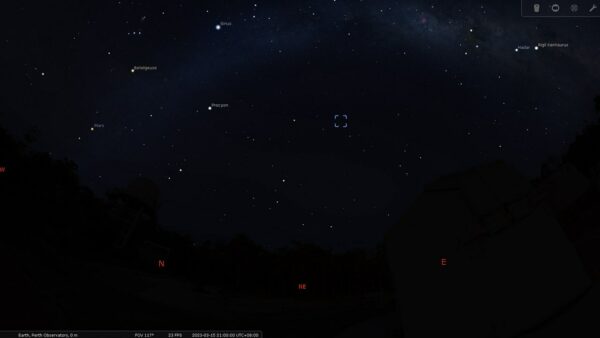
|
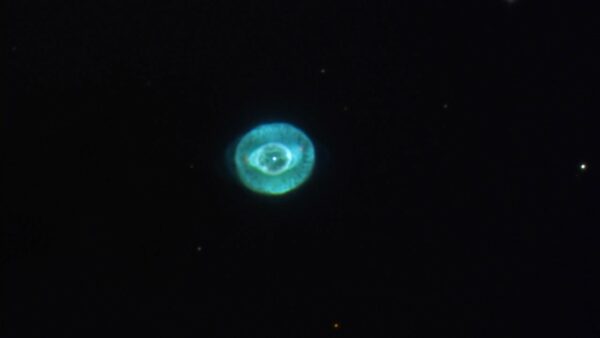
|
Centaurus A Galaxy:
Centaurus A (NGC 5128) is an elliptical galaxy that we see edge-on. The galaxy is the fifth brightest galaxy in the sky and one of the closest radio galaxies to earth. It’s between 10 to 16 million light-years away from us and it can be found in the Centaurus constellation. The galaxy itself has a diameter of 60,000 light-years making it 40% smaller than our galaxy and at its centre, it has a supermassive black hole with a mass of 55 million suns. It was discovered in 1826 by Scottish astronomer James Dunlop from Parramatta, in New South Wales.
It’s a starburst galaxy meaning that it is undergoing a period of intense star formation compared to an average galaxy. Studies have confirmed that this high rate of star birth is caused by a collision between itself and a smaller spiral galaxy. The bright central bulge and the dark dust lane can be easily viewed using an amateur telescope however a larger telescope is required to view greater detail and contrast. Centaurus A is an extremely bright radio object, X-Rays in particular. The central supermassive black hole is the source of this with two long radio jets extending well beyond the visual bounds of the galaxy.
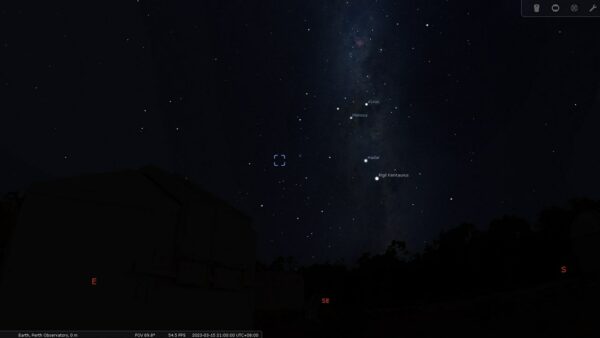
|
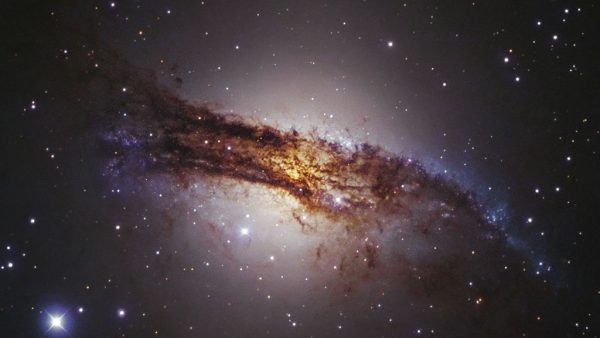
|
Phases Of The Moon:
